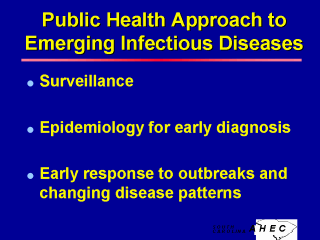| front |1 |2 |3 |4 |5 |6 |7 |8 |9 |10 |11 |12 |13 |14 |15 |16 |17 |18 |19 |20 |21 |22 |23 |24 |25 |26 |27 |28 |29 |30 |31 |32 |33 |34 |35 |review |
 |
The public health approach to addressing emerging infectious disease includes: Surveillance is the ongoing, systematic collection, analysis, and interpretation of health data. It is key to detecting, investigating, and monitoring emerging pathogens, diseases they cause, factors influencing emergence, and response to problems as they are identified. Our nationwide surveillance system requires involvement and resources at all levels. Handout: Reportable diseases in SC. Medical providers (clinics, emergency rooms, labs) are required to report any of these conditions to the local health department; some require urgent action. These disease reports are monitored at the local level and sent to Columbia for state wide surveillance. Columbia in turns send data to the CDC as part of national surveillance. Epidemiology provides early diagnosis and response to outbreaks and changing disease patterns, and allows for the detection of causes of disease or spread of disease even before specific laboratory diagnosis is made. Methods include risk assessment, investigation, interviewing individuals, fact finding, consultation with state epidemiologists/CDC, analysis of laboratory data, diagnosis verification, cause determination, and mobilization of the Epi team. Early response includes rapid notification and immediate action to monitor changing disease patterns and medical management. Medical management includes medical interventions and treatment, safety measures, infection control, and isolation. |
| front |1 |2 |3 |4 |5 |6 |7 |8 |9 |10 |11 |12 |13 |14 |15 |16 |17 |18 |19 |20 |21 |22 |23 |24 |25 |26 |27 |28 |29 |30 |31 |32 |33 |34 |35 |review |